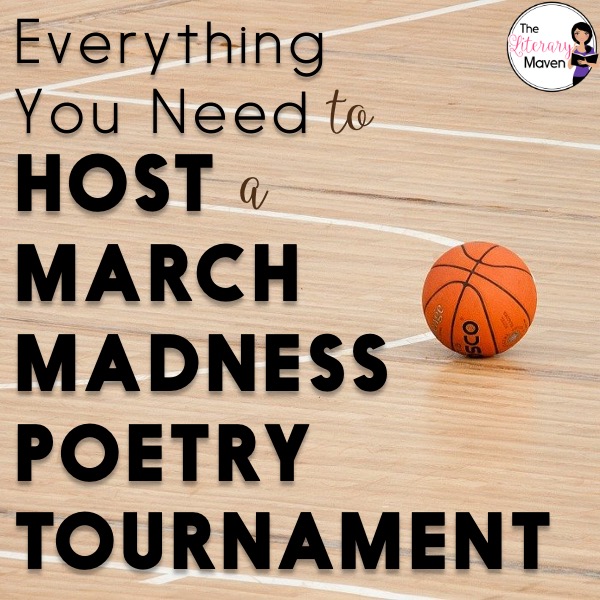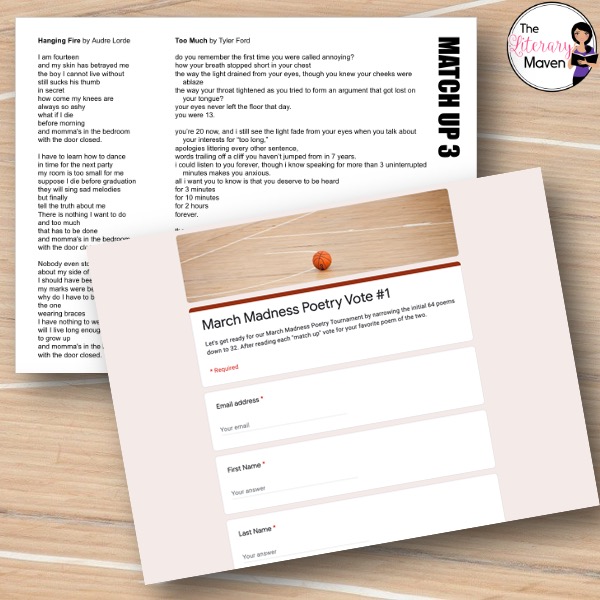Unfortunately schools closed last year in the middle of the month due to the coronavirus and our March Madness Tournament had to get a reset when learning resumed online in April. All of our poem examinations and voting had to shift to online activities. After operating on a hybrid schedule the following year, I have finally been able to bring everything back in person.
Getting Started
The first thing to decide is how many poems you want to include in your tournament. I go for the full 64 to be true to the NCAA tournament, but know some teachers narrow that down to 32 or even just 16. On day one of the tournament, I have students read through all 64 poems and do an initial vote of their favorites the 64 poems are paired by similar topic and many include links to readings of the poem (by the poet if possible).
Click here to make a copy of the Google Slides with the original 64 poems and click here to view the Google Form for the initial voting. Since I've help this tournament multiple times, I've updated my 64 poems to include more diverse voices. Click here to make a copy of the Google Slides with the updated poems and click here to view the Google Form for the initial voting.
I have a very wide bulletin board in my classroom that I use to hang up my bracket and update daily. Click here to make a copy of the Google Slides with the original printable bracket or here to make a copy of the Google Slides with the updated bracket. You can see the highlight video on Instagram that shows it all together here.
Taking A Closer Look
Once we've narrowed the original 64 down to 32, we start to take a closer look at the poems, rereading 4 a day and spending about a week focused on different elements: tone, language, making connections, theme, and the importance of titles. Many of the elements are ones we've learned earlier in the year, so I do a quick mini-lesson to review. Click here to make a copy of the Google Slides with the mini-lessons.
First up is tone. We review that tone is the author’s attitude toward a subject, or how the author feels about who or what they are writing about. I give the students a list of 25+ words they could use to describe the tone of the poem. As we read or listen to the poems each day that week, I ask students to give examples of words in each poem that help to reveal the tone. Students record the tone of each poem and then vote for their favorite of each pair in a Google Form. Click here to view that Google Form.
Next up is language. We review that authors use figurative language and descriptive language to bring their poems to life and create images in their readers’ minds. I provide definitions of similes, metaphor, personification, and imagery for students. As we read or listen to the poems each day that week, I ask students to give examples of figurative language or imagery in each poem. Students record the types of language used in each poem and then vote for their favorite of each pair in a Google Form. Click here to view that Google Form.
Then we move on to making connections. I reassure students that poetry can be challenging to read and understand. Making connections is a strategy they can use to help find meaning in any text by connecting it to their background knowledge. I review the three different types of connections they might make with a text: text to self, text to text, and text to world. As we read or listen to the poems each day that week, I ask students to give examples of connections they can make with the poems. Students record those connections and then vote for their favorite of each pair in a Google Form. Click here to view that Google Form.
After that, we dip our toes into theme. I tell students that themes in poetry can be quite obvious, but that isn’t always the case. Sometimes the theme doesn’t make itself clear and is instead up to the reader. I encourage them to read aloud the poem as that often helps with understanding the theme. I give students a list of 25+ “big ideas” or topics that can help to determine the theme of a poem (note: I do teach my students that theme is a statement, not just one word, and that these topics are just a starting point for theme). As we read or listen to the poems each day, I ask students to give examples of "big ideas" they find in the poems. Students record those "big ideas" and then vote for their favorite of each pair in a Google Form. Click here to view that Google Form.
Finally, we examine the importance of titles. I remind students that authors choose their words for a reason, especially in poetry when an author is using so few words to express their ideas. The title of a poem might be the most important word choice of all because it's the first thing they see and can shape the way they understand the poem. I provide students with some questions to help them decide why the poet chose a particular title for their poem. As we read or listen to the poems each day, I ask students to give reasons why they think the authors chose the titles of the poems. Students record those reasons and then vote for their favorite of each pair in a Google Form. Click here to view that Google Form.
Wrapping Up The Tournament
The final vote asks students to chose their favorite of the last two poems standing. I ask them to provide reasons why they chose that poem and ask them to give reasons connected to the elements we've examined: tone, language, making connections, theme, and the importance of titles. I also ask them to share their favorite of the initial 64 poems. Click here to view that Google Form. The next day in class, I reveal the winner of the tournament and we give it one last read or listen to celebrate.
You can find all of my resources for the March Madness Poetry Tournament here and all of my other resources for teaching poetry here.





Wonderful event, detailed and well-explained. Thank you, I am very excited.
ReplyDeleteHey there. I am thinking about doing something similar this year with my students. I'm a little confused about you mini lessons. Do you focus one topic at a time for that weeks poems? Or do you use the same poems for each topic before moving on to new ones?
ReplyDeleteYes, I spend about a week focused on different elements: tone, language, making connections, theme, and the importance of titles.
DeleteHello! Thank you so much for sharing so many wonderful resources. I used your poetry pairings last year, and it was awesome! It looks like the pairings are the same in 2023 as they were in 2022. Do you have an updated version? Am I clicking the wrong links?
ReplyDeleteHi Stephanie,
DeleteI just added the updated bracket to this blog post this year, but if you subscribe to my emails you may have received the updated bracket last year there.
Best,
Brynn